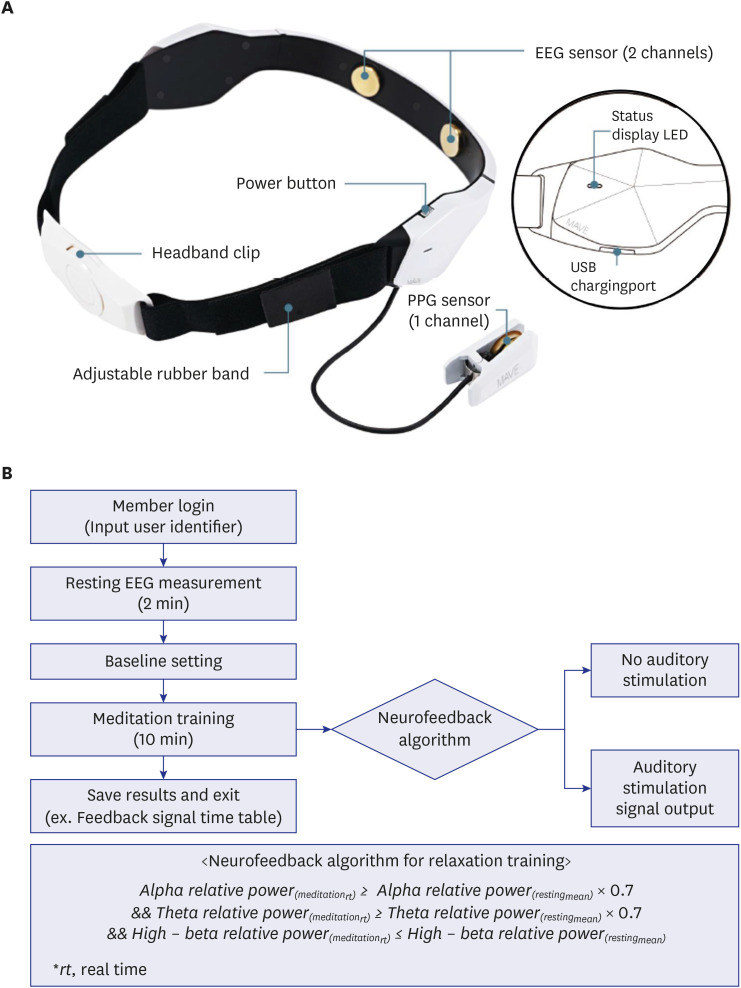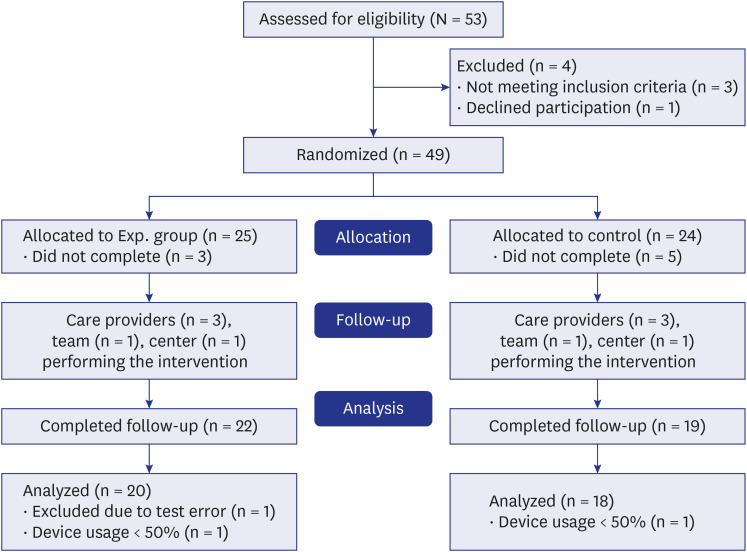J Korean Med Sci.
2024 Mar;39(9):e94. 10.3346/jkms.2024.39.e94.
Modest Effects of NeurofeedbackAssisted Meditation Using a Wearable Device on Stress Reduction: A Randomized, Double-Blind, and Controlled Study
- Affiliations
-
- 1Department of Neuropsychiatry, Seoul National University Bundang Hospital, Seongnam, Korea
- 2Department of Psychiatry, Seoul National University College of Medicine, Seoul, Korea
- 3Department of Psychiatry, Veteran Health Service Medical Center, Seoul, Korea
- KMID: 2553339
- DOI: http://doi.org/10.3346/jkms.2024.39.e94
Abstract
- Background
To evaluate the therapeutic effectiveness and safety of a neurofeedback wearable device for stress reduction.
Methods
A randomized, double-blind, controlled study was designed. Participants had psychological stress with depression or sleep disturbances. They practiced either neurofeedback-assisted meditation (n = 20; female, 15 [75.0%]; age, 49.40 ± 11.76 years) or neurofeedback non-assisted meditation (n = 18; female, 11 [61.1%]; age, 48.67 ± 12.90 years) for 12 minutes twice a day for two weeks. Outcome variables were self-reported questionnaires, including the Korean version of the Perceived Stress Scale, Beck Depression Inventory-II, Insomnia Severity Index, Pittsburgh Sleep Quality Index, and State Trait Anxiety Index, quantitative electroencephalography (qEEG), and blood tests. Satisfaction with device use was measured at the final visit.
Results
The experimental group had a significant change in PSS score after two weeks of intervention compared with the control group (6.45 ± 0.95 vs. 3.00 ± 5.54, P = 0.037). State anxiety tended to have a greater effect in the experimental group than in the control group (P = 0.078). Depressive mood and sleep also improved in each group, with no significant difference between the two groups. There were no significant differences in stress-related physiological parameters, such as stress hormones or qEEG, between the two groups. Subjective device satisfaction was significantly higher in the experimental group than in the control group (P = 0.008).
Conclusion
Neurofeedback-assisted meditation using a wearable device can help improve subjective stress reduction compared with non-assisted meditation. These results support neurofeedback as an effective adjunct to meditation for relieving stress.
Keyword
Figure
Reference
-
1. Chrousos GP, Gold PW. The concepts of stress and stress system disorders. Overview of physical and behavioral homeostasis. JAMA. 1992; 267(9):1244–1252. PMID: 1538563.2. Chrousos GP. Stress and disorders of the stress system. Nat Rev Endocrinol. 2009; 5(7):374–381. PMID: 19488073.3. Burke HM, Davis MC, Otte C, Mohr DC. Depression and cortisol responses to psychological stress: a meta-analysis. Psychoneuroendocrinology. 2005; 30(9):846–856. PMID: 15961250.4. Padgett DA, Glaser R. How stress influences the immune response. Trends Immunol. 2003; 24(8):444–448. PMID: 12909458.5. Esler M, Kaye D. Sympathetic nervous system activation in essential hypertension, cardiac failure and psychosomatic heart disease. J Cardiovasc Pharmacol. 2000; 35(7):Suppl 4. S1–7.6. Lloyd C, Smith J, Weinger K. Stress and diabetes: a review of the links. Diabetes Spectr. 2005; 18(2):121–127.7. Kabat-Zinn J, Massion AO, Kristeller J, Peterson LG, Fletcher KE, Pbert L, et al. Effectiveness of a meditation-based stress reduction program in the treatment of anxiety disorders. Am J Psychiatry. 1992; 149(7):936–943. PMID: 1609875.8. Davidson RJ, Kabat-Zinn J, Schumacher J, Rosenkranz M, Muller D, Santorelli SF, et al. Alterations in brain and immune function produced by mindfulness meditation. Psychosom Med. 2003; 65(4):564–570. PMID: 12883106.9. Jo JM. EEG brainwave analysis for research on meditation influence to the concentration. J Korea Inst Electron Commun Sci. 2014; 9(12):1421–1426.10. Ahn SK. The Effect of Neurofeedback Training on Attention and School Achievement Motivation of primary. J Korea Acad Ind Coop Soc. 2011; 12(12):5525–5530.11. Lardone A, Liparoti M, Sorrentino P, Rucco R, Jacini F, Polverino A, et al. Mindfulness meditation is related to long-lasting changes in hippocampal functional topology during resting state: a magnetoencephalography study. Neural Plast. 2018; 2018:5340717. PMID: 30662457.12. Balconi M, Fronda G, Crivelli D. Effects of technology-mediated mindfulness practice on stress: psychophysiological and self-report measures. Stress. 2019; 22(2):200–209. PMID: 30472901.13. Crivelli D, Fronda G, Venturella I, Balconi M. Stress and neurocognitive efficiency in managerial contexts: a study on technology-mediated mindfulness practice. Int J Workplace Health Manag. 2019; 12(2):42–56.14. Brandmeyer T, Delorme A. Meditation and neurofeedback. Front Psychol. 2013; 4:688. PMID: 24109463.15. Teplan M. Fundamentals of EEG measurement. Meas Sci Rev. 2002; 2(2):1–11.16. Sherlin LH, Arns M, Lubar J, Heinrich H, Kerson C, Strehl U, et al. Neurofeedback and basic learning theory: implications for research and practice. J Neurother. 2011; 15(4):292–304.17. Nieto-Vallejo AE, Ramírez-Pérez OF, Ballesteros-Arroyave LE, Aragón A. Design of a neurofeedback training system for meditation based on EEG technology. Rev Fac Ing. 2021; 30(55):e12489.18. Alonso JF, Romero S, Ballester MR, Antonijoan RM, Mañanas MA. Stress assessment based on EEG univariate features and functional connectivity measures. Physiol Meas. 2015; 36(7):1351–1365. PMID: 26015439.19. Attar ET. Review of electroencephalography signals approaches for mental stress assessment. Neurosciences. 2022; 27(4):209–215. PMID: 36252972.20. Chen C, Xiao X, Belkacem AN, Lu L, Wang X, Yi W, et al. Efficacy evaluation of neurofeedback-based anxiety relief. Front Neurosci. 2021; 15:758068. PMID: 34776855.21. Cheon EJ, Koo BH, Choi JH. The efficacy of neurofeedback in patients with major depressive disorder: an open labeled prospective study. Appl Psychophysiol Biofeedback. 2016; 41(1):103–110. PMID: 26392114.22. Lomas T, Ivtzan I, Fu CH. A systematic review of the neurophysiology of mindfulness on EEG oscillations. Neurosci Biobehav Rev. 2015; 57:401–410. PMID: 26441373.23. Navarro Gil M, Escolano Marco C, Montero-Marín J, Minguez Zafra J, Shonin E, García Campayo J. Efficacy of neurofeedback on the increase of mindfulness-related capacities in healthy individuals: a controlled trial. Mindfulness. 2018; 9(1):303–311.24. Sas C, Chopra R. MeditAid: a wearable adaptive neurofeedback-based system for training mindfulness state. Pers Ubiquitous Comput. 2015; 19(7):1169–1182.25. Hafeez Y, Ali SS, Mumtaz W, Moinuddin M, Adil SH, Al-Saggaf UM, et al. Investigating neurofeedback protocols for stress mitigation: a comparative analysis of different stimulus contents. IEEE Access. 2019; 7:141021–141035.26. Treleaven DA. Trauma-Sensitive Mindfulness: Practices for Safe and Transformative Healing. New York, NY, USA: WW Norton & Company;2018.27. Kim J. Quality grading measure for online digital contents vitalization. J Digit Contents Soc. 2014; 15(2):309–317.28. Yoo K. The development of internet contents evaluation criteria for early childhood education. J Early Child Educ. 2006; 26(5):287–306.29. Cahn BR, Polich J. Meditation states and traits: EEG, ERP, and neuroimaging studies. Psychol Bull. 2006; 132(2):180–211. PMID: 16536641.30. Lee DJ, Kulubya E, Goldin P, Goodarzi A, Girgis F. Review of the neural oscillations underlying meditation. Front Neurosci. 2018; 12:178. PMID: 29662434.31. Lee EH. Review of the psychometric evidence of the perceived stress scale. Asian Nurs Res. 2012; 6(4):121–127.32. Lee J, Shin C, Ko YH, Lim J, Joe SH, Kim S, et al. The reliability and validity studies of the Korean version of the Perceived Stress Scale. Korean J Psychosom Med. 2012; 20(2):127–134.33. Sohn SI, Kim DH, Lee MY, Cho YW. The reliability and validity of the Korean version of the Pittsburgh Sleep Quality Index. Sleep Breath. 2012; 16(3):803–812. PMID: 21901299.34. Cho YW, Song ML, Morin CM. Validation of a Korean version of the Insomnia Severity Index. J Clin Neurol. 2014; 10(3):210–215. PMID: 25045373.35. The WHOQOL Group. Development of the World Health Organization WHOQOL-BREF quality of life assessment. Psychol Med. 1998; 28(3):551–558. PMID: 9626712.36. Akerstedt T, Levi L. Circadian rhythms in the secretion of cortisol, adrenaline and noradrenaline. Eur J Clin Invest. 1978; 8(2):57–58. PMID: 417934.37. Wüst S, Wolf J, Hellhammer DH, Federenko I, Schommer N, Kirschbaum C. The cortisol awakening response - normal values and confounds. Noise Health. 2000; 2(7):79–88.38. Chida Y, Steptoe A. Cortisol awakening response and psychosocial factors: a systematic review and meta-analysis. Biol Psychol. 2009; 80(3):265–278. PMID: 19022335.39. Yu X, Cohen ZP, Tsuchiyagaito A, Cochran G, Aupperle RL, Stewart JL, et al. Neurofeedback-augmented mindfulness training elicits distinct responses in the subregions of the insular cortex in healthy adolescents. Brain Sci. 2022; 12(3):363. PMID: 35326319.40. Koncz A, Demetrovics Z, Takacs ZK. Meditation interventions efficiently reduce cortisol levels of at-risk samples: a meta-analysis. Health Psychol Rev. 2021; 15(1):56–84. PMID: 32635830.41. Bhayee S, Tomaszewski P, Lee DH, Moffat G, Pino L, Moreno S, et al. Attentional and affective consequences of technology supported mindfulness training: a randomised, active control, efficacy trial. BMC Psychol. 2016; 4(1):60. PMID: 27894358.42. Polich G, Gray S, Tran D, Morales-Quezada L, Glenn M. Comparing focused attention meditation to meditation with mobile neurofeedback for persistent symptoms after mild-moderate traumatic brain injury: a pilot study. Brain Inj. 2020; 34(10):1408–1415. PMID: 32783645.43. Crivelli D, Fronda G, Balconi M. Neurocognitive enhancement effects of combined mindfulness–neurofeedback training in sport. Neuroscience. 2019; 412:83–93. PMID: 31195055.44. Anand BK, Chhina GS, Singh B. Some aspects of electroencephalographic studies in Yogis. Electroencephalogr Clin Neurophysiol. 1961; 13(3):452–456.45. Tarrant JM. Neuromeditation: an introduction and overview. Handbook of Clinical QEEG and Neurotherapy. 1st ed. New York, NY, USA: Routledge;2016. p. 96–113.46. Travis F, Shear J. Focused attention, open monitoring and automatic self-transcending: categories to organize meditations from Vedic, Buddhist and Chinese traditions. Conscious Cogn. 2010; 19(4):1110–1118. PMID: 20167507.47. Andrews-Hanna JR. The brain’s default network and its adaptive role in internal mentation. Neuroscientist. 2012; 18(3):251–270. PMID: 21677128.48. van Lutterveld R, Houlihan SD, Pal P, Sacchet MD, McFarlane-Blake C, Patel PR, et al. Source-space EEG neurofeedback links subjective experience with brain activity during effortless awareness meditation. Neuroimage. 2017; 151:117–127. PMID: 26921712.
- Full Text Links
- Actions
-
Cited
- CITED
-
- Close
- Share
- Similar articles
-
- Diabetes Self-Care and Mindfulness Meditation
- Clinical Application of Meditation in Children and Adolescents
- Effects of Auricular Acupressure on Dry Eye Syndrome, Stress, and Depressive Symptoms in Older Adults: A Single-blind, Randomized Controlled Trial
- Effects of cetirizine in dogs with chronic atopic dermatitis: a randomized, double blind, placebo-controlled trial
- Can Fitness Trackers Track Sleep?



